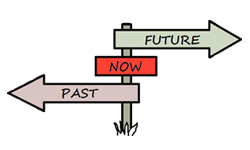Step 3 - A deeper understanding.
Sowing a seed
There is of course a scientific explanation, that the most challenging period of mindfulness practice is the beginning.
- It requires energy to bring in new experiences to the brain.
- There is an inherited resistance to change.
If you use an illustration of the initial difficulties, it can be described as sowing a seed.
- Different seeds need different time to germinate, depending on its background history and heritage (patience).
- The seed needs care and nourishment to survive. I.e. loving and gentle treatment (self-compassion).
- Down in the ground is dark and hard to see which direction to choose in order to reach up to the light (trust).
- But when the first sprout reaches the surface, it's easy to find the right direction and the light increases the power of growing (tipping point).
Observation of the now
Focusing is the central part in mindfulness exercises.
Focusing on something real in the present moment.
Be sure to keep the connection between head and body.
I.e. allow the brain to register signals from the rest of the body (such as the
movement of the belly during breathing or the pressure between the body and its
contact surfaces that it rests on) and
avoid to get stuck in thoughts that has nothing to do with sensations
in the body. Experience true sensations and avoid fantasy or visualisation.
Observe without affecting, evaluate or judge what is experienced. Evaluations and judgments activates
the emotional brain since these thoughts are associated with fears of doing something wrong for example.
Also avoid to focus with force. Observe your focus in a relaxed but alert way.
It is very difficult to observe the breathing without affecting the breathing. Therefore, it can be
helpful to observe a place in the body where the breathing rhythm /wavelike effect is felt, rather
than observing the airflow that goes in and out through the body. A good way is to observe a body part which
is not directly associated with respiration, such as the rhythmic touch between skin and shirt.
To judge your judgements
Be humble around the advice on mindfulness practice. The advice can for example cause judgement on the fact that you
judge yourself for your judgment. Another example is that your strive to let your breathing
be unaffected, affects your breathing.
In short: Make it simple by thinking less!
Without focus on achievment
The best effect of being present, is achieved when you give up the strive of being present.
I.e. the same way as when you have difficulties to fall asleep, you will not fall asleep until you have given up hope of falling asleep.
There is a risk during yoga for example, that the drive of showing off
"good performance" is taking too much room compared to sensing sensations in
the body and to focus on a calm and balanced breathing. The connection between
the head and the body is easely broaken, since it's not possible to focus on sensations
and performance at the same time. The same thing happens if you pass the limit of what
your body is capable of before the head-body contact is broaken during yoga.
Then the breathing will become tense and your focus shifted.
The focus can be other than body sensations. It can for example also be
listening to sounds or sensing a fragrance.
Ground yourself!
In meditation you sometimes hear the term "to be grounded". This means to
feel a solid contact with the surface on which you stand, lay or sit. A sense
of the body "melting" and becomes one with the surface beneath. When the
focus is practiced in a standing position, the grounding is strengthened if
the knees are "unlocked". I.e. the knees are not locked in a maximum upright
position. The knees has freedom to bend in both directions. A very slight bend
of the knees is enough. The position shall still be relaxed and comfortable.
Right focus!
There are people who've been meditating for years, but tried too hard to get the techniqe right. E.g. focused on how to breathe the "right"
way or how to sit "correctly." That is to focuse on technology.
If you do that, it is very difficult to gain the stillness that is sought.
It may be difficult in the beginning to consciously try to be in the experience without thinking: "I want to be in the experience"
(our society is so performance-oriented). It's very hard just "to be" without thinking of trying to just "be".
The hint here is to just breathe into that feeling and to be with that feeling, but above all, be kind to yourself when you discover your strive.
"- True meditation is not about mastering a technique. It's about letting go of control.", Adyashanti
The focus should be just an observation of what is, without influencing, evaluating or judging.
The focus may be what the breath feels like somewhere in the body or examine what the body's contact against the contact surface feels like.
Just watch/ observe, not visualize or intellectualize.
It is very difficult to observe the breathing without affecting the breathing. Therefore, it can be helpful to observe a place in the body
where the breath is felt, rather than observing the stream of air going in and out through the body.
It is good to cut down on sugar and coffee when to practice mindfulness.
These food impair the brain's contact with the rest of the body.
Under construction ......

